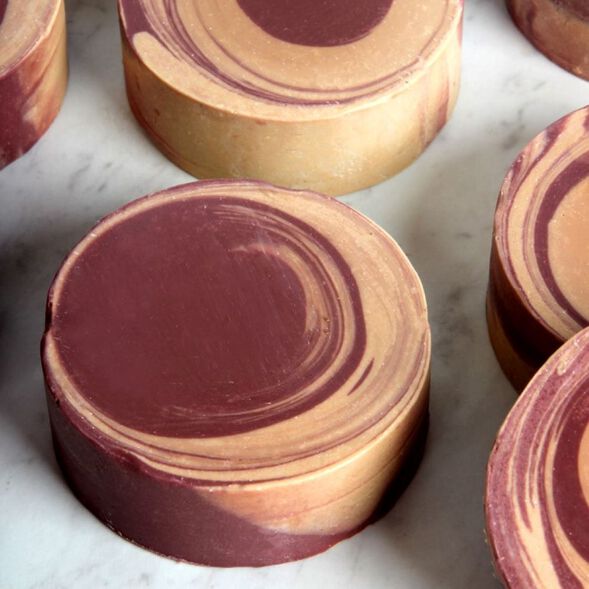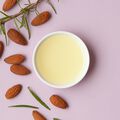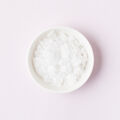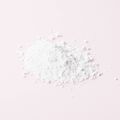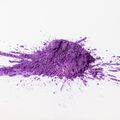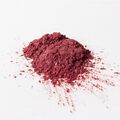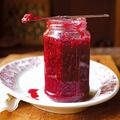
Wine Soap Project
- Skill Level: Intermediate
- Time: 2 hours
- Yield: About 2 pounds of soap
Project Description
Although Napa Valley in California is known for wine, Washington state is the 2nd largest producer in the United States. Most of it is from Eastern Washington, where temperatures are warmer. To highlight this ingredient in our local area, the water in this recipe is swapped for local wine.
Working with wine in soap is not difficult, but it does require some extra prep work. The liquid needs to be boiled first to remove the majority of the alcohol. Then, we like to freeze the liquid before adding the lye. That helps prevent scorching, which in turn prevents darker discoloration and an unpleasant smell.
The red wine gives the soap a dark tan color. Titanium Dioxide Pigment combats this a bit, creating a creamier color. A combination of Queen's Purple Mica and Merlot Sparkle Mica create a rich burgundy-wine color. Raspberry Jam Fragrance Oil gives the soap a realistic and slightly fruity scent.
You will need:
- Silicone Column Mold
- 25 oz. Swirl Quick Mix
- 7.4 oz. Prepped Wine (10% water discount)
- 3.5 oz. Sodium Hydroxide Lye
- 1.5 oz. Raspberry Jam Fragrance Oil
- Titanium Dioxide
- Queen’s Purple Mica
- Merlot Sparkle Mica
WINE PREP: The day before you plan to make soap, add about 12 ounces of wine to a saucepan. You need extra because some will evaporate.
Bring the wine to a steady boil for 5-7 minutes. Do not leave the wine unattended, or it can boil over. Remove from the heat and weigh the amount you need in a separate container. If you have more wine than you need, save it for another batch. If you don’t have enough, add distilled water to make up the difference.
Pour the wine into ice cube trays (in this case we used Medium 9 Ball Silicone Mold) and place it in the freezer overnight. Once it’s frozen, place the wine ice cubes into a heat-safe container.
SAFETY FIRST: Suit up for safe handling practices. That means goggles, gloves, and long sleeves. Make sure kids, pets, other distractions, and tripping hazards are out of the house or don’t have access to your soaping space. Always soap in a well-ventilated area.
Measure 3.5 ounces of sodium hydroxide lye into a separate container. Add about 1/4 of the lye flakes directly to the frozen wine. Mix together slowly.
It takes a few minutes to get started, but the lye will begin to warm up the wine ice cubes and they will begin to melt. You will start to notice an unpleasant odor, and the color of the wine will change (notice the green hue in the photo below). Continue adding the lye flakes to the wine cubes. This process can take a while, so patience is key.
Once all the wine-ice has melted, continue to stir for several minutes to make sure all the lye flakes have completely dissolved. In the photo below, all the ice is melted but there was still some lye flakes at the bottom. To be extra safe, some makers like to pour the lye mixture through a non-reactive mesh strainer to make sure all the flakes are gone. Optional: Add 1.5 teaspoons of sodium lactate to help the bars harden more quickly.
FRAGRANCE PREP: Measure 1.5 oz. of Berrywine Fragrance Oil into a glass container. Set aside.
COLOR PREP: Disperse 4 teaspoons of titanium dioxide into 3 tablespoons of sunflower or sweet almond oil (or any other liquid oil). The color dispersion is slightly more concentrated to avoid adding too much extra oil. Then in separate containers, disperse 1 teaspoon of Queen’s Purple Mica and 1 teaspoon of Merlot Sparkle Mica into 1 tablespoon of lightweight liquid oil. Use a mini mixer to help get rid of any clumps. Optional: To ensure the titanium dioxide blends smoothly into the soap, we recommend micronizing it before dispersing it in oil. Use a coffee grinder to break up any clumps of color and prevent streaks of white from showing in the final soap. We like to use a coffee grinder that has a removable stainless steel mixing area for easy cleaning.
Follow these steps:
1
Fully melt the entire bag of Swirl Quick Mix until it's completely clear and there is no cloudiness. Shake the bag to mix up all the oils. Measure 25 oz. into a large heat-safe container. Add 2 tablespoons of the dispersed titanium dioxide and stick blend until combined.
2
Add the lye water to the oils and stick blend until thin trace. Notice the color change of the soap!
3
Split the batch in half. Each container should have about 500 mL of soap. To one container, add all the dispersed Merlot Sparkle Mica and all the dispersed Queen’s Purple Mica. To the other container of soap, add the remaining dispersed titanium dioxide. Use a whisk to thoroughly mix.
4
Add half of the Raspberry Jam Fragrance Oil to one container of soap, and the other half of the fragrance oil to the other container (it’s okay to eyeball it). Use a whisk to thoroughly mix.
5
Pour some of tan soap into the mold, while counting to “1, 2, 3.” Then, pour the wine colored soap into the cream, directly in the center of the mold while counting to “1, 2, 3.” Counting helps keep the pours consistent. The colors should break through to the layer below.
6
Continue pouring each color into the mold, directly in the center, until the mold is completely full.
7
While firmly holding on to the seals on the sides of the mold, very lightly tap the mold on the counter. Don’t tap too firmly, or the seal of the mold can unlock and your soap will spill everywhere. Set the mold aside in a safe area where it will not topple over.
Because of the extra sugar in the wine, this soap does have a tendency to warm up. Our space was cool, so we left the soap at room temperature for 3-4 days before unmolding. If you live in a hot climate, you may want to place the soap into the fridge for the first 3-4 hours to prevent overheating. Allow the soap to stay in the mold for 3-4 days. Because of the amount of colorant/extra oil in the recipe, we found it took a little longer to unmold. Once unmolded, slice into bars and allow to cure for 4-6 weeks. Enjoy!
Tutorial credits
Photographer: Amanda Kerzman

Wine Soap Project
- Skill Level: Intermediate
- Time: 2 hours
- Yield: About 2 pounds of soap
Project Description
Although Napa Valley in California is known for wine, Washington state is the 2nd largest producer in the United States. Most of it is from Eastern Washington, where temperatures are warmer. To highlight this ingredient in our local area, the water in this recipe is swapped for local wine.
Working with wine in soap is not difficult, but it does require some extra prep work. The liquid needs to be boiled first to remove the majority of the alcohol. Then, we like to freeze the liquid before adding the lye. That helps prevent scorching, which in turn prevents darker discoloration and an unpleasant smell.
The red wine gives the soap a dark tan color. Titanium Dioxide Pigment combats this a bit, creating a creamier color. A combination of Queen's Purple Mica and Merlot Sparkle Mica create a rich burgundy-wine color. Raspberry Jam Fragrance Oil gives the soap a realistic and slightly fruity scent.
You will need:
- Silicone Column Mold
- 25 oz. Swirl Quick Mix
- 7.4 oz. Prepped Wine (10% water discount)
- 3.5 oz. Sodium Hydroxide Lye
- 1.5 oz. Raspberry Jam Fragrance Oil
- Titanium Dioxide
- Queen’s Purple Mica
- Merlot Sparkle Mica
WINE PREP: The day before you plan to make soap, add about 12 ounces of wine to a saucepan. You need extra because some will evaporate.
Bring the wine to a steady boil for 5-7 minutes. Do not leave the wine unattended, or it can boil over. Remove from the heat and weigh the amount you need in a separate container. If you have more wine than you need, save it for another batch. If you don’t have enough, add distilled water to make up the difference.
Pour the wine into ice cube trays (in this case we used Medium 9 Ball Silicone Mold) and place it in the freezer overnight. Once it’s frozen, place the wine ice cubes into a heat-safe container.
SAFETY FIRST: Suit up for safe handling practices. That means goggles, gloves, and long sleeves. Make sure kids, pets, other distractions, and tripping hazards are out of the house or don’t have access to your soaping space. Always soap in a well-ventilated area.
Measure 3.5 ounces of sodium hydroxide lye into a separate container. Add about 1/4 of the lye flakes directly to the frozen wine. Mix together slowly.
It takes a few minutes to get started, but the lye will begin to warm up the wine ice cubes and they will begin to melt. You will start to notice an unpleasant odor, and the color of the wine will change (notice the green hue in the photo below). Continue adding the lye flakes to the wine cubes. This process can take a while, so patience is key.
Once all the wine-ice has melted, continue to stir for several minutes to make sure all the lye flakes have completely dissolved. In the photo below, all the ice is melted but there was still some lye flakes at the bottom. To be extra safe, some makers like to pour the lye mixture through a non-reactive mesh strainer to make sure all the flakes are gone. Optional: Add 1.5 teaspoons of sodium lactate to help the bars harden more quickly.
FRAGRANCE PREP: Measure 1.5 oz. of Berrywine Fragrance Oil into a glass container. Set aside.
COLOR PREP: Disperse 4 teaspoons of titanium dioxide into 3 tablespoons of sunflower or sweet almond oil (or any other liquid oil). The color dispersion is slightly more concentrated to avoid adding too much extra oil. Then in separate containers, disperse 1 teaspoon of Queen’s Purple Mica and 1 teaspoon of Merlot Sparkle Mica into 1 tablespoon of lightweight liquid oil. Use a mini mixer to help get rid of any clumps. Optional: To ensure the titanium dioxide blends smoothly into the soap, we recommend micronizing it before dispersing it in oil. Use a coffee grinder to break up any clumps of color and prevent streaks of white from showing in the final soap. We like to use a coffee grinder that has a removable stainless steel mixing area for easy cleaning.
Follow these steps:
1
Fully melt the entire bag of Swirl Quick Mix until it's completely clear and there is no cloudiness. Shake the bag to mix up all the oils. Measure 25 oz. into a large heat-safe container. Add 2 tablespoons of the dispersed titanium dioxide and stick blend until combined.
2
Add the lye water to the oils and stick blend until thin trace. Notice the color change of the soap!
3
Split the batch in half. Each container should have about 500 mL of soap. To one container, add all the dispersed Merlot Sparkle Mica and all the dispersed Queen’s Purple Mica. To the other container of soap, add the remaining dispersed titanium dioxide. Use a whisk to thoroughly mix.
4
Add half of the Raspberry Jam Fragrance Oil to one container of soap, and the other half of the fragrance oil to the other container (it’s okay to eyeball it). Use a whisk to thoroughly mix.
5
Pour some of tan soap into the mold, while counting to “1, 2, 3.” Then, pour the wine colored soap into the cream, directly in the center of the mold while counting to “1, 2, 3.” Counting helps keep the pours consistent. The colors should break through to the layer below.
6
Continue pouring each color into the mold, directly in the center, until the mold is completely full.
7
While firmly holding on to the seals on the sides of the mold, very lightly tap the mold on the counter. Don’t tap too firmly, or the seal of the mold can unlock and your soap will spill everywhere. Set the mold aside in a safe area where it will not topple over.
Because of the extra sugar in the wine, this soap does have a tendency to warm up. Our space was cool, so we left the soap at room temperature for 3-4 days before unmolding. If you live in a hot climate, you may want to place the soap into the fridge for the first 3-4 hours to prevent overheating. Allow the soap to stay in the mold for 3-4 days. Because of the amount of colorant/extra oil in the recipe, we found it took a little longer to unmold. Once unmolded, slice into bars and allow to cure for 4-6 weeks. Enjoy!
Tutorial credits
Photographer: Amanda Kerzman
You will need:
- Silicone Column Mold
- 25 oz. Swirl Quick Mix
- 7.4 oz. Prepped Wine (10% water discount)
- 3.5 oz. Sodium Hydroxide Lye
- 1.5 oz. Raspberry Jam Fragrance Oil
- Titanium Dioxide
- Queen’s Purple Mica
- Merlot Sparkle Mica
WINE PREP: The day before you plan to make soap, add about 12 ounces of wine to a saucepan. You need extra because some will evaporate.
Bring the wine to a steady boil for 5-7 minutes. Do not leave the wine unattended, or it can boil over. Remove from the heat and weigh the amount you need in a separate container. If you have more wine than you need, save it for another batch. If you don’t have enough, add distilled water to make up the difference.
Pour the wine into ice cube trays (in this case we used Medium 9 Ball Silicone Mold) and place it in the freezer overnight. Once it’s frozen, place the wine ice cubes into a heat-safe container.
SAFETY FIRST: Suit up for safe handling practices. That means goggles, gloves, and long sleeves. Make sure kids, pets, other distractions, and tripping hazards are out of the house or don’t have access to your soaping space. Always soap in a well-ventilated area.
Measure 3.5 ounces of sodium hydroxide lye into a separate container. Add about 1/4 of the lye flakes directly to the frozen wine. Mix together slowly.
It takes a few minutes to get started, but the lye will begin to warm up the wine ice cubes and they will begin to melt. You will start to notice an unpleasant odor, and the color of the wine will change (notice the green hue in the photo below). Continue adding the lye flakes to the wine cubes. This process can take a while, so patience is key.
Once all the wine-ice has melted, continue to stir for several minutes to make sure all the lye flakes have completely dissolved. In the photo below, all the ice is melted but there was still some lye flakes at the bottom. To be extra safe, some makers like to pour the lye mixture through a non-reactive mesh strainer to make sure all the flakes are gone. Optional: Add 1.5 teaspoons of sodium lactate to help the bars harden more quickly.
FRAGRANCE PREP: Measure 1.5 oz. of Berrywine Fragrance Oil into a glass container. Set aside.
COLOR PREP: Disperse 4 teaspoons of titanium dioxide into 3 tablespoons of sunflower or sweet almond oil (or any other liquid oil). The color dispersion is slightly more concentrated to avoid adding too much extra oil. Then in separate containers, disperse 1 teaspoon of Queen’s Purple Mica and 1 teaspoon of Merlot Sparkle Mica into 1 tablespoon of lightweight liquid oil. Use a mini mixer to help get rid of any clumps. Optional: To ensure the titanium dioxide blends smoothly into the soap, we recommend micronizing it before dispersing it in oil. Use a coffee grinder to break up any clumps of color and prevent streaks of white from showing in the final soap. We like to use a coffee grinder that has a removable stainless steel mixing area for easy cleaning.
Follow these steps:
1
Fully melt the entire bag of Swirl Quick Mix until it's completely clear and there is no cloudiness. Shake the bag to mix up all the oils. Measure 25 oz. into a large heat-safe container. Add 2 tablespoons of the dispersed titanium dioxide and stick blend until combined.
2
Add the lye water to the oils and stick blend until thin trace. Notice the color change of the soap!
3
Split the batch in half. Each container should have about 500 mL of soap. To one container, add all the dispersed Merlot Sparkle Mica and all the dispersed Queen’s Purple Mica. To the other container of soap, add the remaining dispersed titanium dioxide. Use a whisk to thoroughly mix.
4
Add half of the Raspberry Jam Fragrance Oil to one container of soap, and the other half of the fragrance oil to the other container (it’s okay to eyeball it). Use a whisk to thoroughly mix.
5
Pour some of tan soap into the mold, while counting to “1, 2, 3.” Then, pour the wine colored soap into the cream, directly in the center of the mold while counting to “1, 2, 3.” Counting helps keep the pours consistent. The colors should break through to the layer below.
6
Continue pouring each color into the mold, directly in the center, until the mold is completely full.
7
While firmly holding on to the seals on the sides of the mold, very lightly tap the mold on the counter. Don’t tap too firmly, or the seal of the mold can unlock and your soap will spill everywhere. Set the mold aside in a safe area where it will not topple over.
Because of the extra sugar in the wine, this soap does have a tendency to warm up. Our space was cool, so we left the soap at room temperature for 3-4 days before unmolding. If you live in a hot climate, you may want to place the soap into the fridge for the first 3-4 hours to prevent overheating. Allow the soap to stay in the mold for 3-4 days. Because of the amount of colorant/extra oil in the recipe, we found it took a little longer to unmold. Once unmolded, slice into bars and allow to cure for 4-6 weeks. Enjoy!
Tutorial credits
Photographer: Amanda Kerzman

